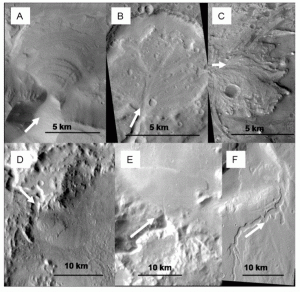Rivers that run into lakes and other standing bodies of water drop sediment where the flow slackens as it enters the body of water. Over time, the accumulating material builds a delta — a wedge of sediment whose form can tell scientists about both the river’s activity and that of the body of water.

DOWN IN THE DELTA. Laboratory experiments show that most deltas on Mars form inside crater lakes, and were likely built by short-duration floods. The biggest factor controlling the delta's form is the water level in the lake while the delta is building. Falling water levels cause channel erosion, rising levels cause multiple back-stepping lobes of sediment, and steady levels cause outward growing deltas, with or without multiple surface channels. (Image taken from Figure 1 in the paper.)
Three planetary scientists at Utrecht University, Netherlands, modeled the development of different kinds of Martian deltas using a laboratory stream table. They found that most deltas on Mars formed by short, catastrophic floods, rather than (as is common on Earth) longer periods of fluvial activity. Germari de Villiers led the group, which reports on their findings in the Journal of Geophysical Research.
The scientists explain that deltas on Earth are shaped by upstream factors such as climate, geology, and vegetation, and by factors in the downstream receiving basin, such as basin morphology, waves, tides, and sea level fluctuations.
Not all such factors apply to Mars, as the researchers note. For example, “Martian deltas commonly formed in impact crater lakes with average diameters of around 40 kilometers [25 miles], so waves were probably insignificant.” Likewise, Mars has no moon big enough to raise tides and no vegetation to interfere with erosion patterns.
To investigate in the lab, the team used a flume filled with sand and water flowing into a circular crater-like basin. By varying the flow and the level of water in the basin, they simulated various geological situations and climate changes.
“The experiments show that delta formation occurs by a sequence of events beginning with high-discharge flows of relatively high sediment concentration,” say the reseachers. What happens then depends on the level of water in the lake or basin, which becomes gradually filled by the flood. “The behavior of the downstream water level is the most important factor determining delta morphology.”
If the water level in the crater lake rises during the flow, the delta will build numerous lobes of sediment that step backward toward the incoming flow. If the water level remains constant, then the delta grows and may or may not develop channels on the delta. And if the water level falls, the delta deposit becomes incised by channels that cut down into its sediments. This last case is seen in the experiments, but not with Martian deltas.
From their experiments, three implications for Martian deltas emerged, according to the scientists. First, the early stages of delta building involve a highly energetic, hyper-concentrated flow — like a flash flood — which deposits most of the sediments. Second, channel incision in a delta is focused and occurs rapidly. This finding led the researchers to believe that after the high-discharge event no modifications of the delta body took place, which in turn suggests that the crater lake dried out slowly and that the delta was formed by a single event.
Third, the experiments indicated that water soaking into the subsoil of the channel and crater lake probably leads scientists to underestimate the total volume of water.
A flood making a Martian delta likely ended about as abruptly as it began, the team says. If there was significant late-stage flow, the water would cut into the existing delta — and they note, “almost all deltas on Mars show no large-scale erosion by post-formation flow over their surface.”
This led the team to an observation about climate. “The preservation of numerous deltas on Mars, mostly without indications of fluvial erosion, leads us to argue that the climate may not have been warm and wet and sustaining long-duration hydrological activity throughout Mars’ history.”
More likely, they say, a given catastrophic event led to instant production of flood waters which quickly filled a crater basin. The floods that formed the delta ended abruptly, and the crater lake soon dried up, leaving the delta exposed.
“We therefore conclude that rapid formation by single, high discharge events was most likely responsible for most of these delta deposits on Mars.”








